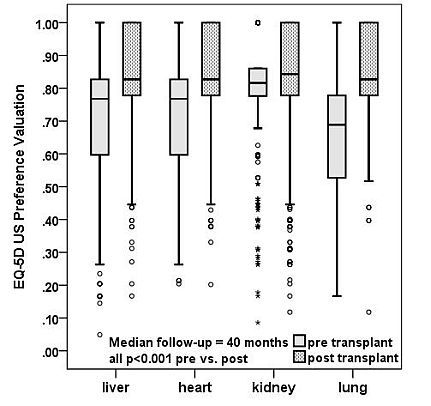Differing Responsiveness of EQ-5D Preference Valuations to Solid Organ Transplantation: Implications for Cost-Utility Analyses
Transplant Center, Vanderbilt University Medical Center, Nashville, TN
Department of Surgery, Vanderbilt University Medical Center, Nashville, TN
Department of Biostatistics, Vanderbilt University Medical Center, Nashville, TN
Meeting: 2013 American Transplant Congress
Abstract number: A776
Introduction: EuroQoL (EQ-5D) health-related quality of life surveys can be reported as health status scores and preference valuation (PV) utilities. Our aim was to evaluate the statistical responsiveness of EQ-5D PVs to liver, heart, kidney and lung transplantation and generate effect size estimates applicable to cost-utility analyses.
Methods: Surveys were completed by solid organ transplant patients (before and at 1, 3, 6 months and annually post-transplant) using rolling enrollment. Responses on the 5 EQ-5D domains were converted to PVs using US population-based weights that range from -0.11 (worst) to 1.00 (best). Maximal differences for cross-sectional data were tested using non-parametric methods and expressed as effect sizes [(post-pre)/SD]. Linear mixed effects models evaluated organ-specific differences in longitudinal trajectories of PVs.
Results: The sample included 2718 adults (766 liver, 283 heart, 1460 kidney, 209 lung) and 5008 data points. The overall proportion of persons reporting no problems was significantly higher after transplantation in all domains (p<0.001) and response patterns varied between the organ groups. Similarly, post-transplant PVs were significantly higher in all organ groups with effect sizes ranging from 0.3 (kidney) to 0.9 (lung) [Figure]. Longitudinal data demonstrated overall improvement in PVs over time (p<0.001) and a difference in organ group trajectories (time by organ interaction p=0.012). Liver and thoracic transplant patients had significantly steeper trajectories than kidney transplant patients (p<0.05).
Conclusion: The positive impact of transplantation on patient-reported EQ-5D preference valuations is significant but not uniform across solid organ types. Differences in responsiveness and effect sizes should be considered when designing and interpreting cost-utility analyses.

To cite this abstract in AMA style:
Zaman A, Dageforde L, Zavala E, Hameed A, Wright A, Ye H, Moore D, Feurer I. Differing Responsiveness of EQ-5D Preference Valuations to Solid Organ Transplantation: Implications for Cost-Utility Analyses [abstract]. Am J Transplant. 2013; 13 (suppl 5). https://atcmeetingabstracts.com/abstract/differing-responsiveness-of-eq-5d-preference-valuations-to-solid-organ-transplantation-implications-for-cost-utility-analyses/. Accessed December 21, 2025.« Back to 2013 American Transplant Congress
